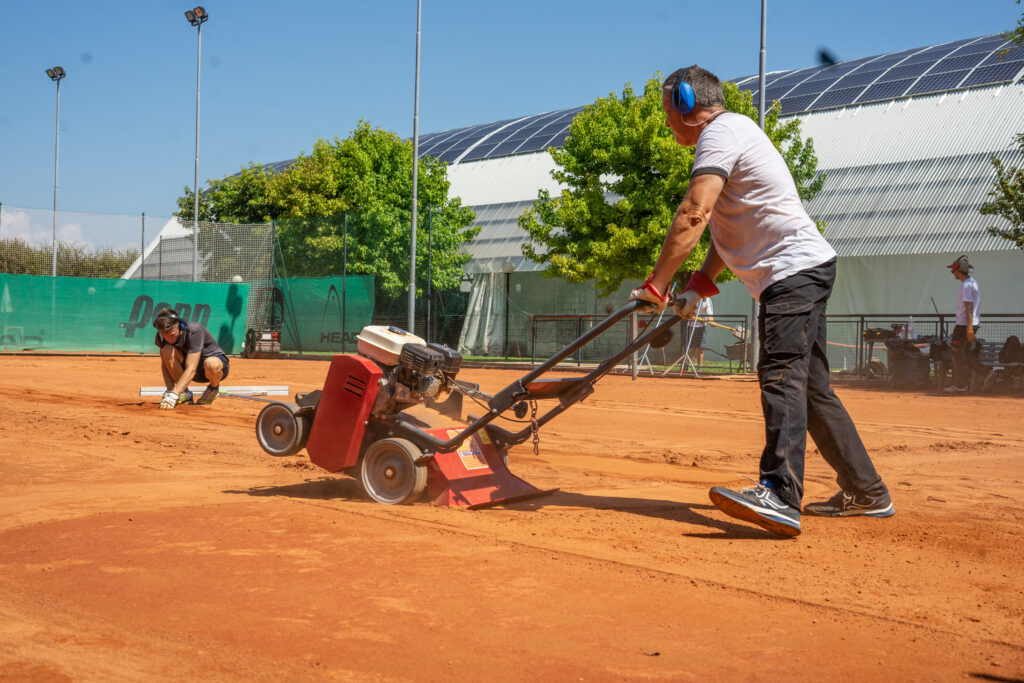ARCUT 2.0
To refresh a red clay court, it is often enough to use an ordinary rake, but this costs a lot of time and effort.
Arcut 2.0, on the other hand, is extremely maneuverable and allows a single operator to do the restoration work more quickly and with a better yield as far as the end result is concerned.
With the Arcut 2.0, you can also save on adding more material because it can regenerate the existing soil so that it can compact with any new soil.
Contact us to purchase or rent ARCUT 2.0 and start enjoying its benefits now.

ARCUT 1.0
The structure is inspired by that of an aerator, modified to be more powerful and more maneuverable.
The first prototype while looking very solid had difficulties with several components: the wheel supports, the center pivot, and the frame, due to engine vibration.
After a study of asphalt breaking machines and a series of tests it was decided to reinforce the machine frame and change the cutting system. Thus ARCUT 2.0 was born, more robust and capable of breaking any court.
TECHNICAL FEATURES
Arcut 2.0 is type-approved and can be used within circles without the need for special permits.
The back of the machine has all safety information, certifications and approvals.
The machine is made in collaboration with the FBC of Maniago (PN) and features:
- Loncin G200F engine, power 6.5 hp and with gasoline fuel supply;
- Rear guard with “ground level” function;
- Safety handle;
- Cutting depth adjustable between 0 – 3 cm depending on the work to be done;
- Cutting width equal to 50 cm;
- 42 blades with Widia tips that can be replaced individually.
USAGE
The Arcut 2.0 has a handle to move the cutting system: raise it when moving and lower it by adjusting the cutting depth when working.
There is no graduated measurement because depending on the consumption of the blades you can have different cutting depths. So the first thing to do is to test how deep you go.
Specifically 0.5cm for scratching and about 1.5cm for breaking the crust, without removing the surface coat.
It is important not to go over the stripes with the machine, because the blades may tear them apart.
And it is advisable to always act on the wet court, to avoid dust and make the work easier.
After the first pass with the Arcut 2.0, there is no need to go over again in the opposite direction. Should you pass twice in the same direction and on the same section of land, the working depth would increase and its penetration into the soil would increase.
With only one pass the subsoil is already workable, but there may be places where the machine has not been able to get a grip. In those cases it means that the court in those places is concave and you need to add soil, new or that of the piles that have been broken up.
After these steps you can proceed with rolling and the next steps needed to finish the job.
ALTERNATIVE METHODS FOR FRESHING THE COURT
Low-impact scheduled interventions are the solution to almost any problem that can affect tennis courts throughout the year. This means they are interventions that need to be done often and well.
Every sports club has its own method for breaking up the hard soil crust that forms over time and due to the weather.
But every method, more or less rudimentary, has its downsides:
- An ordinary rake or shovel, means making more effort and taking longer;
- Improvised systems such as aerators, power tillers, breakers, mill the court roughly and unevenly, creating small plots to be broken otherwise;
- Craft-made machinery for maintenance, are very bulky and very expensive;
- Machines such as plows, motorcultivators and agricultural harrows, require professional maintainers and are very expensive;
Based on this overview, it is easy to deduce that a machine designed specifically to pulverize the playing surface, which does not require much effort from the user and guarantees a good job quickly, such as the ARCUT 2.0, is the best solution for all sports centers.



